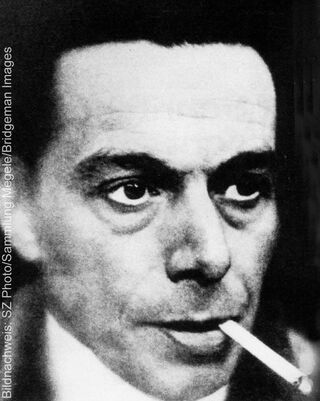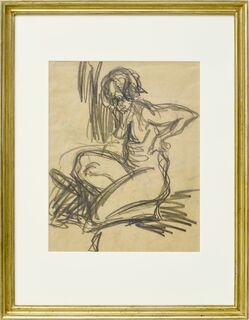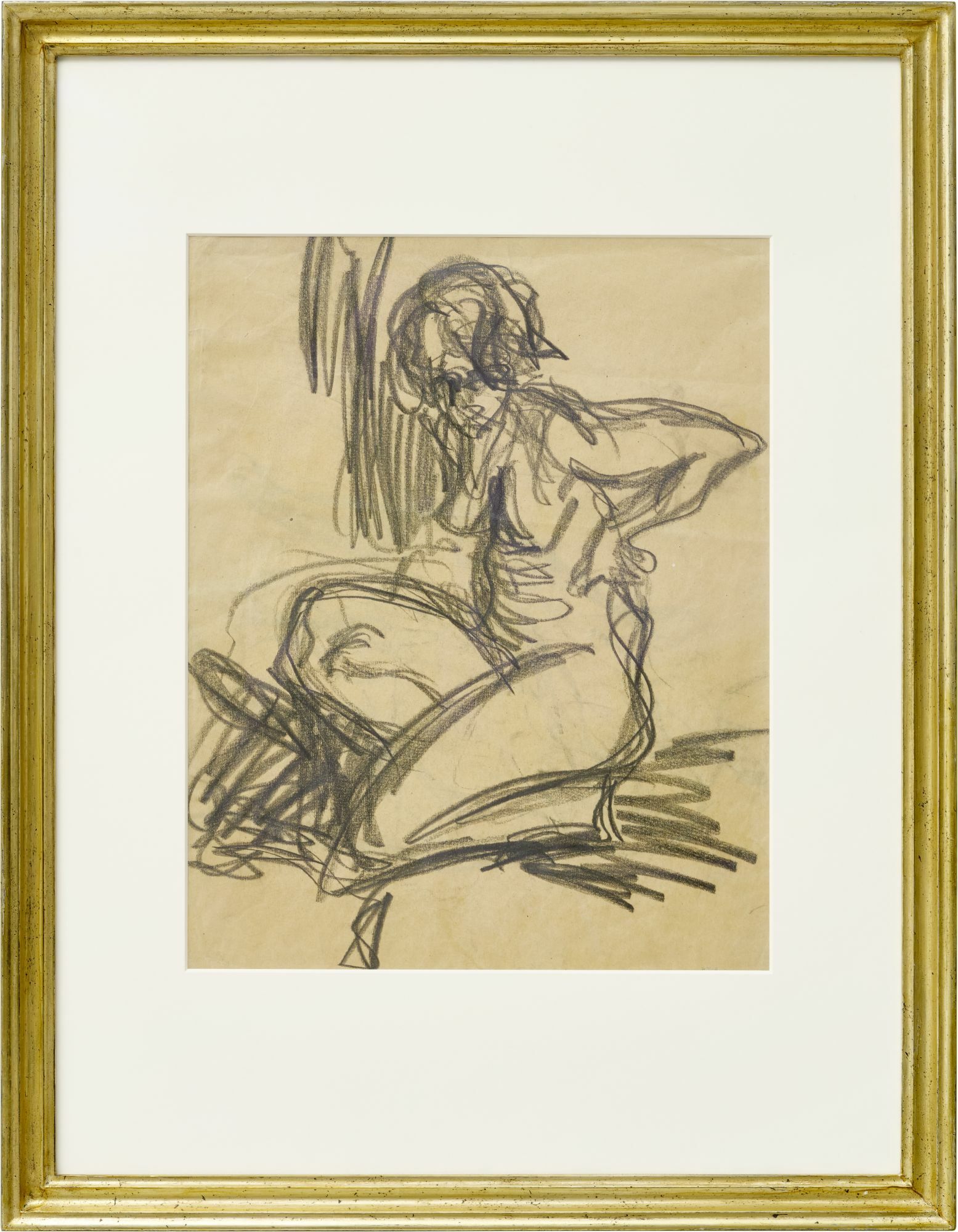Picture "Kneeling Nude" (1905/06) (Unique piece)


Picture "Kneeling Nude" (1905/06) (Unique piece)
Quick info
unique piece | certified | stamped | chalk on paper | framed | size 68 x 56.5 cm
Video
Detailed description
Picture "Kneeling Nude" (1905/06) (Unique piece)
Ernst Ludwig Kirchner together with Erich Heckel, Ernst Ludwig Kirchner and Fritz Bleyl, founded the famous artists' group "Die Brücke" at the time this unique piece was painted.
He sketched this kneeling female nude with her arm propped at her side around 1905. He draws the model, whose face disappears in the shadows and under a curly pageboy cut, in rough strokes on toned wrapping paper. The light areas of skin create a powerful physicality, while the shading, executed with vehemence, models the spatial situation in the studio.
The intuitively groping yet expressive strokes and the angled limbs of the woman's depiction lend the naked body a defensiveness and wildness that is a most remarkable complement to the art-historically traditional subject of the sleeping Venus.
Black chalk drawing, 1905/06. On buff wove paper. With the estate stamp of the Kunstmuseum Basel (Lugt 1570 b) and the handwritten registration number "B Dre/Bg 17" on the verso. With a certificate from the Ernst Ludwig Kirchner Archive. Motif size/sheet size 43 x 34 cm. Size in frame 68 x 56.5 cm as shown.

About Ernst Ludwig Kirchner
1880-1938
Ernst Ludwig Kirchner was one of the founders of the artist‘s group "Die Brücke" (The Bridge) and one of the most important representatives of Expressionism. His oeuvre includes around 30,000 paintings, drawings, sketches and sculptures.
When a person's fear becomes too great and the purpose of life is not only threatened but also taken away, it is often only seen one way out: self-chosen death. This is what happened to Ernst Ludwig Kirchner, who took his own life by gunshot on a mountain pasture above Davos on 15 June 1938. Before that, however, he destroyed his woodblocks and a large number of his sculptures out of fear of the invasion of German troops.
Kirchner was born in Aschaffenburg, Germany, on 6 May 1880 but moved to Switzerland on 13 October 1918. After several stays in sanatoriums because of severe depression and drug abuse in Germany, his friends admitted him to the doctor Ludwig Spengler in Davos.
The First World War, for which Kirchner volunteered for military service, triggered his anxiety. His "Self-Portrait as a Soldier" of 1915 was a testimony to his inner state of mind.
Kirchner was a painter who always reproduced his immediate surroundings in oil, woodcut, etching and also sculpture. Therefore, his work is structured through several phases. As a co-founder of the artist‘s group "Die Brücke" in 1905, he represented a strongly colourful and expressive style of painting, the themes of which are mainly the so-called "quarter-hour nudes" as well as city scenes of Dresden and Berlin. With the "discovery" of open-air painting, the nudes moved from the studio to the open air, in 1904 to the Moritzburg lakes, and from 1908 to Fehmarn.
After the ending of the group "Die Brücke" in 1913, Kirchner chose Berlin street scenes as a new motif, depicting the milieu of the cocottes with hard strokes and black outlines. For a long time, a critical view of the fringe groups of society took over from his paradisiacal landscape painting.
It was not until he returned to Switzerland that he found inner peace and equilibrium. His Swiss paintings of the 1920s are captivating for their colour harmonies and flowing forms.
In addition to painting and graphic art, the artist, who lived in an alpine hut, also devoted himself to sculpture. However, the National Socialists' seizure of power and the defamation of 639 of his works as "degenerate art" once again fuelled the fears of the sensitive artist and led him to his tragedy.
A one-of-a-kind or unique piece is a work of art that has been personally created by the artist. It exists only once due to the type of production (oil painting, watercolours, drawing, etc.).
In addition to the classic unique pieces, there exist the so-called "serial unique pieces". They present a series of works with the same colour, motif and technique, manually prepared by the same artist. The serial unique pieces are rooted in "serial art", a type of modern art, that aims to create an aesthetic effect through series, repetitions and variations of the same objects or themes or a system of constant and variable elements or principles.
In the history of arts, the starting point of this trend was the work "Les Meules" (1890/1891) by Claude Monet, in which for the first time a series was created that went beyond a mere group of works. The other artists, who addressed to the serial art, include Claude Monet, Piet Mondrian and above all Gerhard Richter.


